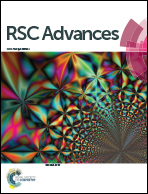A simple fluorescence assay for trypsin through a protamine-induced carbon quantum dot-quenching aggregation platform†
Abstract
The development of a simple detection strategy for trypsin (Try) is urgent, and is ascribed to the diagnostic value of Try in several diseases. Herein, a facile but effective fluorescence strategy for Try was developed based on the protamine (Pro)-induced aggregation of carbon quantum dots (CQDs). The fluorescence of negatively charged CQDs was quenched with Pro due to the assembly of CQDs and Pro (CQDs/Pro) through electrostatic interaction. However, the highly positively charged Pro, which is rich in basic arginine residues, was preferred to be hydrolyzed by Try. Try can induce the deaggregation of CQDs/Pro, thereby enabling the release of CQDs to restore the fluorescence intensity. Thus, the use of CQDs/Pro as a testing platform will be employed as a “turn-on” method for Try. In addition, the fluorescence-resuming response was proportional to Try, ranging from 25 ng mL−1 to 500 ng mL−1 with a limit of detection (LOD) of 8.08 ng mL−1. This “turn-on” fluorescence assay for Try was label-free, convenient, and relatively free of interference from coexisting substances. Actual applications for Try monitoring and trypsin inhibitor screening also illustrated the considerable prospect of CQDs in the clinical field, combined with the superiority of the simple mixing operation.



 Please wait while we load your content...
Please wait while we load your content...